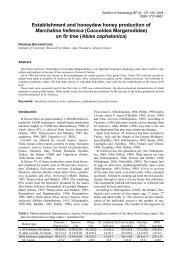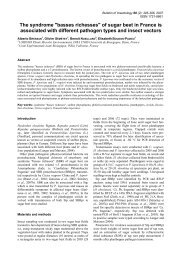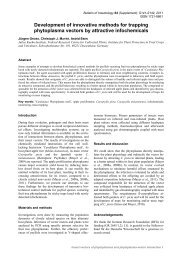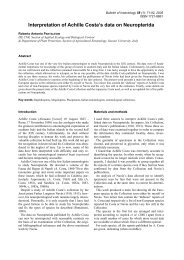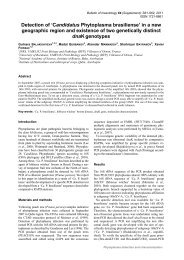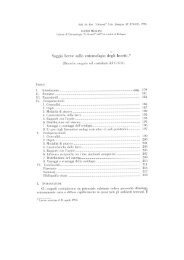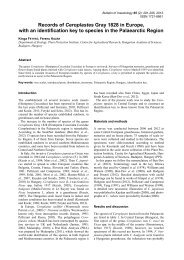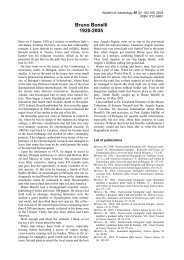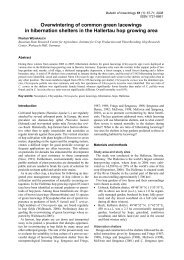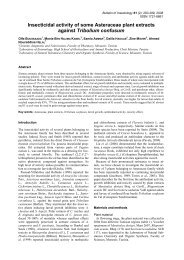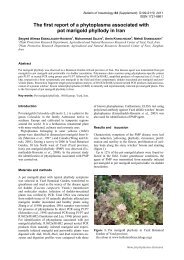Efficacy of kaolin, spinosad and malathion against Ceratitis capitata ...
Efficacy of kaolin, spinosad and malathion against Ceratitis capitata ...
Efficacy of kaolin, spinosad and malathion against Ceratitis capitata ...
Create successful ePaper yourself
Turn your PDF publications into a flip-book with our unique Google optimized e-Paper software.
(Puterka et al., 2000; Pasqualini et al., 2002), olive fruit<br />
fly, Bactrocera oleae (Gmelin) (Saour <strong>and</strong> Makee<br />
2003), pistachio psyllid, Agonoscena targionii (Lichtenstein)<br />
(Saour, 2005), <strong>and</strong> C. <strong>capitata</strong>, on nectarine, apple<br />
<strong>and</strong> persimmon (Mazor <strong>and</strong> Erez, 2004).<br />
This study aimed at evaluating the efficacy <strong>of</strong> the <strong>kaolin</strong>-based<br />
product Surround WP <strong>and</strong> <strong>of</strong> the <strong>spinosad</strong>based<br />
insecticide Success Appât <strong>against</strong> C. <strong>capitata</strong> on<br />
orange in two Tunisian study sites with different climatic<br />
conditions in comparison with the organo-phosphate insecticide<br />
<strong>malathion</strong> <strong>and</strong> an untreated control.<br />
Materials <strong>and</strong> methods<br />
Field trials were conducted in two study sites with<br />
Mediterranean climate, the mainl<strong>and</strong> site Sbikha (at approximately<br />
60 km from the sea, 35.40° N, 10.06° E, 60<br />
m above sea level) <strong>and</strong> the coastal site Sidi Bouali (at<br />
approximately 5 km from the sea, 35.55° N, 10.33° E ,<br />
15 m above sea level).<br />
Sbikha orchard<br />
The Sbikha study orchard was located on a farm <strong>of</strong> 20<br />
ha in size, at approximately 30 km from the town Kairouan<br />
in the centre <strong>of</strong> Tunisia.<br />
The trial orchard (size: approximately 0.5 ha) cultivated<br />
with Citrus, C. sinensis (L.) Osbeck, var. Thomson,<br />
consisted <strong>of</strong> 19 rows with 23 trees per row (distance<br />
between rows: 4 m; distance between trees along<br />
row: 3 m; plant age: 28 years). The plot was surrounded<br />
to the north by a row <strong>of</strong> cypress trees bordering a local<br />
road, to the east by a pear <strong>and</strong> fig orchard, to the west<br />
by a pomegranate orchard, <strong>and</strong> to the south by a Citrus<br />
orchard (Clementine, Valencia late, <strong>and</strong> Orange).<br />
To evaluate the efficacy <strong>of</strong> the different treatments, a<br />
r<strong>and</strong>omized block design with 4 replicates <strong>of</strong> 4 trees per<br />
treatment was used. Blocks <strong>and</strong> plots were arranged in<br />
one area <strong>of</strong> the study orchard along 8 adjacent rows using<br />
8 trees per row. The following treatments were<br />
compared: 1. Kaolin (formulated product -f.p-. Surround<br />
WP; concentration a.i. 95%; applied rate: 5 kg<br />
f.p. /100 l); 2. <strong>spinosad</strong> (f.p. Success Appât; concentration<br />
a.i. 24%; applied rate: 1 l f.p. /ha; 3. <strong>malathion</strong> (f.p.<br />
Fyfanon 50 EC from Cheminova Agro A/S, Denmark;<br />
concentration a.i.: 50%; applied rate: 200 ml f.p. /l00 l);<br />
4. untreated control. The first treatment was applied on<br />
September 28, 2005; at that date the mean weekly male<br />
captures in the traps were 49 (see below), <strong>and</strong> fruits<br />
were still developing. Two additional applications were<br />
carried out on October 19, <strong>and</strong> November 10, 2005.<br />
Products were applied with a manually operated knapsack<br />
sprayer with 16 l <strong>of</strong> capacity (Model H-103 Himatic<br />
Agro, India) calibrated to deliver 2.0 l <strong>of</strong> liquid<br />
suspension per tree.<br />
The remaining area <strong>of</strong> the study orchard was treated<br />
with the grower’s st<strong>and</strong>ard control strategy (applications<br />
<strong>of</strong> <strong>malathion</strong> on September 3, 19, 29, October 15, 30,<br />
<strong>and</strong> on November 10 <strong>and</strong> 24, 2005).<br />
Temperature data were collected from a meteorological<br />
station located at about 26 kilometres from the study<br />
orchard.<br />
40<br />
C. <strong>capitata</strong> flight activity<br />
To monitor the flight activity <strong>of</strong> C. <strong>capitata</strong> males,<br />
after the first treatment (September 28), 16 modified<br />
Steiner traps (Steiner, 1952), produced locally <strong>and</strong> each<br />
containing a cotton wick (3.5 cm in length by 1 cm in<br />
diameter) baited with a 2-3 ml solution <strong>of</strong> trimedlure<br />
(90%) <strong>and</strong> <strong>malathion</strong> (10%) (v:v) <strong>and</strong> refilled every four<br />
to five weeks, were used: in each plot, one trap was<br />
hung on the first <strong>of</strong> the four trees (4 monitoring traps<br />
per treatment) at a height <strong>of</strong> 1.2 - 1.5 m. The distance<br />
between traps varied from 6 m along blocks to 8 m between<br />
blocks. The number <strong>of</strong> males captured per trap<br />
was recorded weekly.<br />
Fruit damage<br />
Due to the relatively low number <strong>of</strong> fruit per tree, we<br />
decided to inspect all 4 trees <strong>of</strong> each plot for fruit damage.<br />
To avoid biasing <strong>of</strong> data due to old fruit damage,<br />
prior to applying the first treatment, all trees were surveyed<br />
for damaged fruits, <strong>and</strong> attacked fruits (punctured<br />
<strong>and</strong> dropped fruits) were removed. Additional assessments<br />
for damaged fruits were conducted once a week<br />
throughout the study period. Punctured fruits were recorded<br />
<strong>and</strong> marked, <strong>and</strong> dropped fruits were recorded<br />
<strong>and</strong> removed. At the end <strong>of</strong> the study period, the total<br />
number <strong>of</strong> punctured <strong>and</strong> dropped fruits per tree was<br />
calculated.<br />
Sidi Bouali orchard<br />
The Sidi Bouali study orchard was located on a farm<br />
<strong>of</strong> approximately 6 ha in size, cultivated mostly with<br />
different Citrus <strong>and</strong> pomegranate cultivars. The study<br />
orchard was surrounded to the north by prickly pear, to<br />
the east by pomegranate, to the south by orange (C. sinensis<br />
(L.) Osbeck) var. Maltaise <strong>and</strong> Clementine (C.<br />
clementina Hort. ex Tanaka), <strong>and</strong> to the west by different<br />
Citrus fruits (orange var. Valencia late, lemon, <strong>and</strong><br />
sweet orange).<br />
The study orchard was approximately 0.5 ha in size,<br />
<strong>and</strong> consisted <strong>of</strong> 15 rows <strong>of</strong> 24-year-old Citrus trees, C.<br />
sinensis (L.) Osbeck var. Thomson, with 8 trees per<br />
row. The study orchard was divided into 4 plots, different<br />
in size: one plot <strong>of</strong> two rows was sprayed with <strong>kaolin</strong><br />
(f.p. Surround WP; applied rate: same as above), an<br />
adjacent additional plot <strong>of</strong> two rows was treated with<br />
<strong>spinosad</strong> (f.p. Success Appât; applied rate: same as<br />
above), one plot <strong>of</strong> 10.5 rows was treated with<br />
<strong>malathion</strong> (f.p. Fyfanon 50 EC; applied rate: same as<br />
above), while 4 trees <strong>of</strong> the last row were used as untreated<br />
control plot.<br />
Treatments (<strong>kaolin</strong>, <strong>spinosad</strong>, <strong>and</strong> <strong>malathion</strong>) were<br />
applied for the first time on October 14, when the average<br />
weekly number <strong>of</strong> males captured per trap was<br />
180.5, <strong>and</strong> repeated on October 29, <strong>and</strong> November 17.<br />
Due to the high infestation level, two additional sprays<br />
were applied to the <strong>spinosad</strong>- <strong>and</strong> the <strong>malathion</strong>-treated<br />
plot on November 8 <strong>and</strong> 21. All sprays were applied<br />
with the same knapsack sprayer used in Sbikha, but the<br />
sprayer was calibrated to deliver 3 l <strong>of</strong> solution per tree.<br />
Before the beginning <strong>of</strong> the trial, the entire study orchard<br />
was treated with <strong>malathion</strong> by the grower on<br />
September 8, 22, <strong>and</strong> on October 8.



